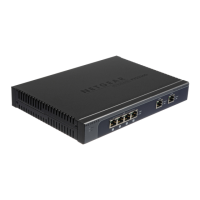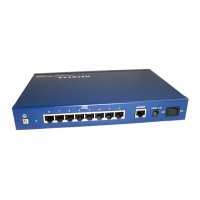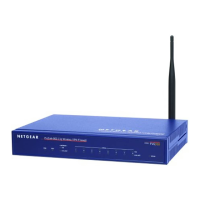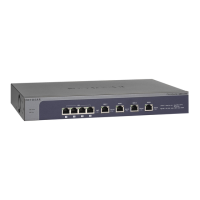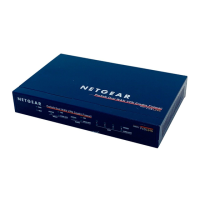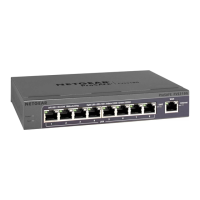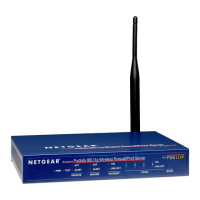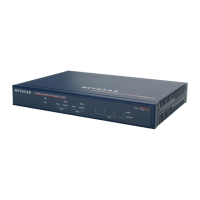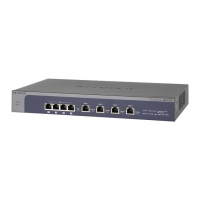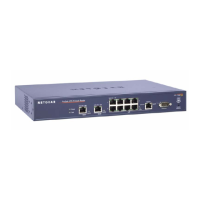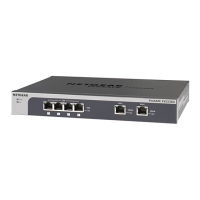Do you have a question about the NETGEAR ProSafe FVS114 and is the answer not in the manual?
| VPN Support | Yes |
|---|---|
| Number of Ports | 4 |
| Power Supply | 12V DC, 1A |
| VPN tunnels | Up to 5 |
| Protocols | IPSec, PPTP |
| Port Speed | 10/100 Mbps |
| DoS/DDoS Protection | Yes |
| URL Filtering | Yes |
| Weight | 1.5 lbs |
| Firewall features | Stateful Packet Inspection |
| Firewall Type | Stateful Packet Inspection (SPI) |
| Interfaces | 4 x 10/100 Mbps Ethernet ports, 1 x 10/100 Mbps WAN port |
Defines the manual's intended audience, scope, and typographical conventions.
Explains how to navigate and utilize the HTML version of the manual.
Provides instructions for printing pages, chapters, or the entire manual.
Highlights the main capabilities and security features of the FVS114 VPN Firewall.
Details the features that simplify the firewall's setup and administration.
Lists the items included in the FVS114 VPN Firewall product package.
Describes the status LEDs and components on the front panel of the firewall.
Identifies the ports and features located on the rear panel of the firewall.
Pre-installation considerations for connecting the VPN firewall to your network.
Step-by-step instructions for physically connecting the firewall to your network.
Guides through the initial configuration process to establish Internet connectivity.
Provides solutions for common problems encountered during setup and connection.
Detailed steps for manually configuring the firewall's Internet connection settings.
Explains the firewall's protective capabilities and content filtering features.
Details how to restrict access based on web addresses and keywords.
Defines how to create rules for blocking or allowing specific traffic types.
Explains how to configure inbound rules for port forwarding.
Configures the firewall to send email notifications for logs and alerts.
Describes how to view security-related event logs on the firewall.
Provides an overview of client-to-gateway and gateway-to-gateway VPN configurations.
Step-by-step guide to configure a VPN tunnel between a remote PC and the firewall.
Detailed steps for configuring the VPN tunnel on the FVS114 using the VPN Wizard.
Steps to configure the VPN client software on the remote computer.
Guide to configure a VPN tunnel between two network gateways.
Procedures for deactivating a configured VPN tunnel for testing purposes.
Explains the policy-based VPN configuration and interoperability.
Describes creating policy definitions for managing VPN traffic.
Details automatic key and authentication management using IKE policies.
Steps for configuring VPN policies using automatic key negotiation.
Steps for configuring VPN policies using manual key exchange.
Explains using digital certificates for IKE authentication.
Provides example scenarios for typical FVS114 VPN configurations.
Describes how to view the router's status and usage information.
Instructions for downloading and installing new firewall firmware.
Covers saving, restoring, and erasing firewall configuration settings.
Details the process of saving current firewall settings to a file.
Explains how to load saved configuration settings back to the firewall.
Guides on how to change the firewall's administrative password for security.
Describes how to use diagnostic tools like Ping and Trace Route.
Configures WAN connection settings, DMZ server, and ping responses.
Sets up dynamic DNS service to maintain a consistent domain name.
Configures LAN IP services, including DHCP and RIP.
Enables the firewall to act as a DHCP server for network devices.
Adds static routing information for specific network configurations.
Allows authorized users to manage the firewall remotely over the Internet.
Configures Universal Plug and Play for automatic device discovery and network access.
Describes the expected sequence of events when powering on the firewall.
Troubleshooting steps for when the power LED does not illuminate.
Steps to diagnose issues when LAN or Internet port LEDs are not active.
Resolves problems accessing the firewall's web-based configuration interface.
Guides on resolving issues related to obtaining a WAN IP address from the ISP.
Resets the firewall to factory defaults, including password and IP address.
Lists supported network protocols and industry standards.
Provides dimensions and weight details for the firewall hardware.
Details operating temperature and humidity requirements.
Explains the fundamental principles of router functionality.
Covers IP addressing structure and its role on the Internet.
Explains techniques for splitting IP networks into smaller subnetworks.
Describes how Network Address Translation allows multiple PCs to share one IP.
Explains how DHCP automatically assigns network configuration information.
Defines a firewall's role in protecting networks from intrusion.
Defines Virtual Private Networks and their purpose.
Explains the IPSec standard for data authentication, integrity, and confidentiality.
Details the security features provided by IPSec.
Describes the ESP protocol for VPN data security.
Explains the AH protocol for VPN data authentication and integrity.
Defines the Security Association (SA) in IPSec VPNs.
Explains the role of IKE in managing encryption keys for VPNs.
Provides methods for testing and troubleshooting VPN configurations.
Ensures computers have TCP/IP installed and configured for networking.
Steps to configure TCP/IP on older Windows operating systems.
Guides on enabling DHCP for automatic network configuration.
Specific steps for configuring TCP/IP using DHCP in Windows XP.
Confirms TCP/IP settings after configuration, using winipcfg.exe.
Steps to configure TCP/IP on Windows NT4, 2000, and XP systems.
Instructions to gather necessary ISP configuration data from Windows PCs.
Instructions to gather necessary ISP configuration data from Macintosh computers.

